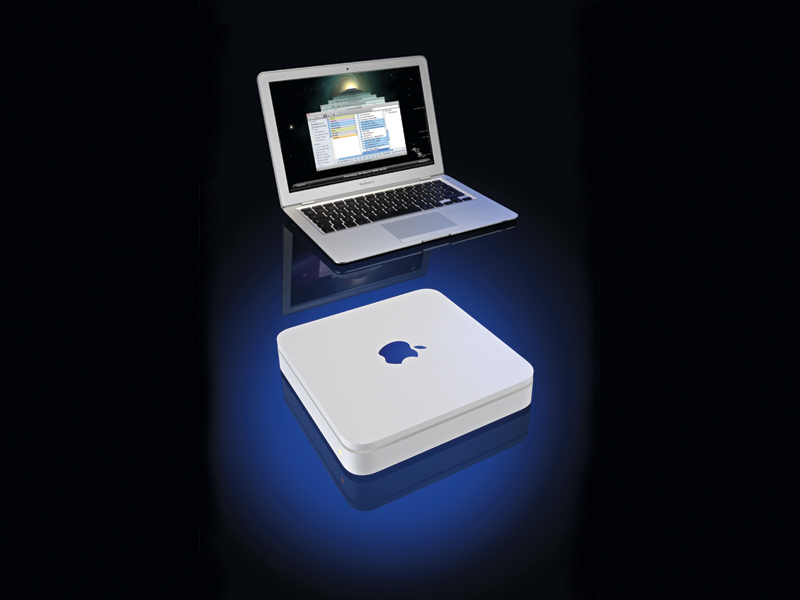TechRadar Verdict
No single backup strategy offers absolute insurance against data loss, but Time Capsule is a solid choice for the average user
Pros
- +
Automatic, transparent, wireless backup
- +
Easy to use
- +
Versioned, incremental
- +
Share printers and disks to Macs and PCs
Cons
- -
Slow initial backup
- -
No convenient way to secure backups
Why you can trust TechRadar
We're going to say this up front: buy one of these now.
We don't care if you've never backed up a byte of data, or already have an existing backup regime; Time Capsule's transparent, zero-intervention, newbie-friendly system is the best we have ever used.
Once the Time Capsule is set up, all the Macs on a network will back up automatically every hour, in the background and, assuming your Macs are connected wirelessly, without having to plug anything in. Plus, you can step back in time in hour-long increments to find and restore earlier versions of your files, or files that you might have deleted.
This is powered by Leopard's Time Machine engine, so you need to have Mac OS X 10.5 to get the best out of Time Capsule. (You can, of course, use it as a vanilla network disk with any modern operating system, including Windows.)
Setting up Time Capsule
Setup is easy, but there is a catch. Just plug the Time Capsule into a power socket and fire up the AirPort Utility installed from the CD. It will scan for Time Capsule and, when it's found it, temporarily join its wireless network - switching from any existing wireless network you have just until you get set up - then take you through configuration.
You're given three choices: add the Time Capsule to an existing wireless network; use it to create a wireless network; or connect it to your network or computer using Ethernet.
Sign up for breaking news, reviews, opinion, top tech deals, and more.
If you already have an 802.11n base station from any manufacturer, you'll probably just choose to have the Time Capsule join its existing network as a client device.
If your base station is an Apple one or supports WDS, you can choose to use the Time Capsule to boost and extend your wireless network.
If you have a router that uses 802.11g, 802.11b or even doesn't have any wireless abilities at all, you can plug the Time Capsule into it using Ethernet to create an 802.11n network that's fast, robust and wide-ranging.
You're unlikely to be able to dump your broadband router: while it's rare to find router/modems which don't do the 'modem' bit, Apple's own base stations have sadly never included broadband modems.
Connecting over Ethernet
The final option is to connect the Time Capsule over Ethernet.
This does seem a bit retrograde but it's essential that the option exists: it lets you tether the Time Capsule to a more secure wired network - though, of course, it supports WEP, WPA and WPA2; and it's much faster.
This shouldn't matter much after the initial backup - you'll only be trickling in the data you've added in the last hour - but the initial backup can take a long time over WiFi.
This is particularly true if you're backing up from an older Mac with 802.11g connectivity; it doesn't matter that the Time Capsule can create an N network; if the client devices are G it'll be slow.
Sluggish backup
We found it impractical to do an initial backup over WiFi; you can easily set it up as an Ethernet device first, then switch to wireless, but there's no mention of this in the manual. You can also attach a printer or a hard disk and share them to a mix of Macs and PCs.
Restoring files from a backup is easy but potentially sluggish. Time Machine even lets you restore an entire disk, and there's provision on the Leopard installer disk from which you'd boot to allow you to connect to a network and restore from a Time Capsule.
Not perfect
The system isn't flawless.
If you encrypt your home folder using FileVault, Time Machine will only back it up when you're logged out of your account, and if you don't then your data is readable by any shared users to whom you have given access to the Time Capsule.
It's also slow to do the initial backup - and there's no help guiding you through the process of doing the initial backup over Ethernet and then switching to wireless.
Plus, the fact that Apple refuses to include a modem means that you still need another device on your network.
A phenomenal product
We'd have liked to have seen some location awareness so that laptop users - who may have a hard disk tethered as a Time Machine volume at work, but a Time Capsule at home - can switch automatically; at present, that requires a delve into System Preferences each time you move.
We're annoyed, too, that Apple is prevaricating over the same Time Machine-over-WiFi functionality for USB disks connected to AirPort Extreme base stations, but in spite of all of this, Time Capsule is still a phenomenal product.
It's the epitome of set-it-and-forget-it ease, and for that, Apple deserves a medal.
The TechRadar hive mind. The Megazord. The Voltron. When our powers combine, we become 'TECHRADAR STAFF'. You'll usually see this author name when the entire team has collaborated on a project or an article, whether that's a run-down ranking of our favorite Marvel films, or a round-up of all the coolest things we've collectively seen at annual tech shows like CES and MWC. We are one.
